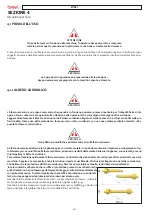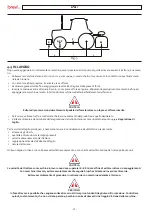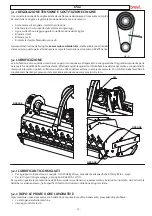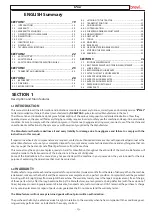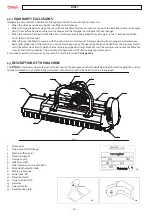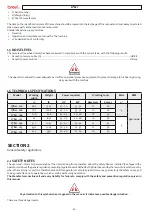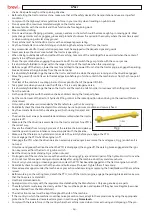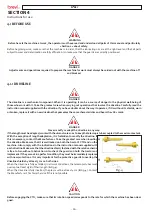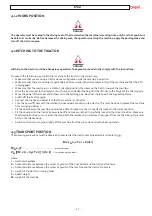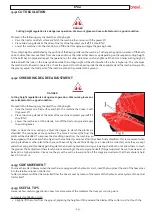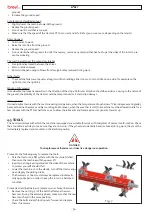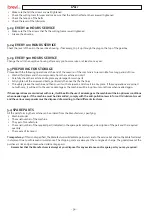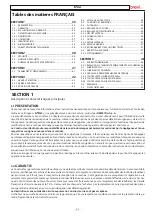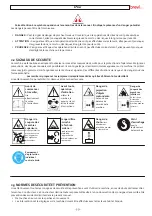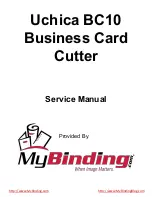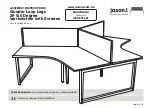
- 24 -
W
VU
chains. Keep well away from the spinning driveline.
Before starting the tractor and machine, make sure that all the safety devices for transportation and use are in perfect
ȡ
conditions.
Comply with the Highway Code regulations in force in your country when travelling on public roads.
ȡ
Do not exceed the maximum tolerated weight on the tractor axles.
ȡ
Become familiar with the controls and their functions before beginning work.
ȡ
Wear suitable clothing.
ȡ
ƪǡ ǡ Ǥ
ȡ
protective garments such as goggles, gloves and protective footwear if required in the country where the machine is used
or when working on particular stony ground.
The machine must be hitched to a tractor with an adequate power rating.
ȡ
Pay the utmost attention when hitching and unhitching the machine to and from the tractor.
ȡ
Any accessories used for transportation purposes must be equipped with adequate signs and guards.
ȡ
Never ever leave the driver’s seat whilst the tractor is operating.
ȡ
When driving round bends with and without the machine, take care of the centrifugal force exercised when the center of
ȡ
ơǤ
ǦơǤ
͙͘͘͘͘͜͝Ǥ
ȡ
It is absolutely forbidden to linger within the range of action of the machine when this is operating.
ȡ
ơ ǡ ǡ ǡ
ȡ
brake and remove the ignition key from the control panel.
It is absolutely forbidden to get between the tractor and machine while the engine is running and the driveline engaged.
ȡ
Move the power lift control lever to the locked position before you hitch or unhitch the machine to or from the three-point
ȡ
linkage.
The class of the machine’s coupling pins must correspond to that of the power lift hitch.
ȡ
Take great care when you work near the lift links. This is a very dangerous area.
ȡ
It is absolutely forbidden to get between the tractor and the machine hitch in order to manoeuvre the lifting command
ȡ
from the outside.
Fix the side lifting links with the relative chains and idlers during the transport phase.
ȡ
Set the control lever of the tractor’s hydraulic lifting control in the locked position when driving on the roads with the ma-
ȡ
chine raised.
Only use the driveline recommended by the Manufacturer, with «CE» marking.
ȡ
Ǥ ƤǤ
ȡ
Pay the utmost attention to the driveline guard, both during transport and
ȡ
work.
The driveline must always be assembled and disassembled when the tractor
ȡ
ơǤ
Make sure that the driveline is assembled on the tractor and machine PTO in
ȡ
the correct way.
Prevent the shields from turning by means of the relative chains and always
ȡ
read the operation and maintenance manual supplied with the driveline.
Make sure that there are no bystanders or animals in the vicinity before you engage the PTO.
ȡ
ơǤ
ȡ
ȋ͙͘ǡ Ǥ
ȡ
3
) and when it is
not used.
ǡơǡǦ
ȡ
tion key removed from the tractor’s ignition switch.
Rest the driveline on its stand (
ȡ
4
Fig.
1
) when not used.
Prolonged use of the machine can cause the overdrive housing (
ȡ
5
Fig.
1
) and certain parts of the hydraulic circuit to overhe-
at. Do not touch these parts during and immediately after using the machine since they could cause burns.
ơǤ
ȡ
Periodically check to make sure that the nuts and bolts are well torqued. Tighten them if necessary.
ȡ
Place adequate supports under the machine as a precaution when servicing or replacing the tines/blades with the machine
ȡ
raised.
ǡ ǡơ ǡ
ȡ
that the tines are at a standstill.
Use the recommended oils.
ȡ
Spare parts must comply with the requirements established by the Manufacturer. Only use genuine spare parts.
ȡ
The safety decals must always be clearly visible. They must be kept clean and replaced if they become illegible (new ones
ȡ
can be obtained from the Manufacturer).
The instruction manual must be kept throughout the life of the machine.
ȡ
If the country in which the machine is used has noise prevention laws, adapt to these provisions by using the appropriate
ȡ
protections. The measured noise levels are given in section «
1.5 Noise level
».
Comply with the laws in force in the country where the machine is used when it comes to using and disposing of the pro-
ȡ
Fig.3

